博弈论试题
- 格式:pdf
- 大小:38.78 KB
- 文档页数:6
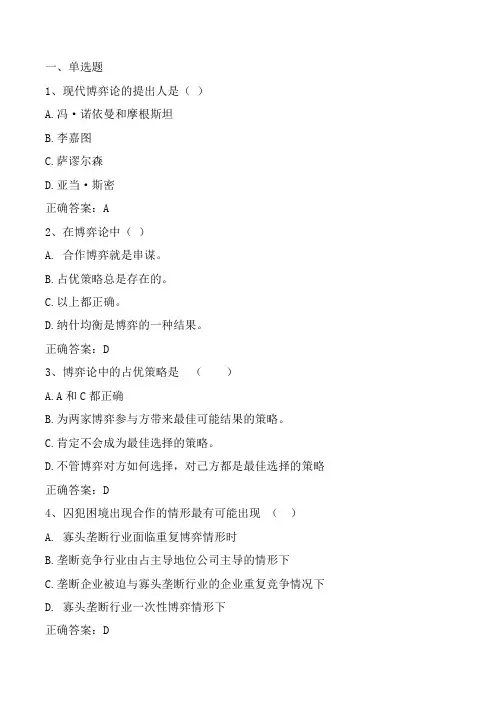
一、单选题1、现代博弈论的提出人是()A.冯·诺依曼和摩根斯坦B.李嘉图C.萨谬尔森D.亚当·斯密正确答案:A2、在博弈论中()A. 合作博弈就是串谋。
B.占优策略总是存在的。
C.以上都正确。
D.纳什均衡是博弈的一种结果。
正确答案:D3、博弈论中的占优策略是()A.A和C都正确B.为两家博弈参与方带来最佳可能结果的策略。
C.肯定不会成为最佳选择的策略。
D.不管博弈对方如何选择,对己方都是最佳选择的策略正确答案:D4、囚犯困境出现合作的情形最有可能出现()A. 寡头垄断行业面临重复博弈情形时B.垄断竞争行业由占主导地位公司主导的情形下C.垄断企业被迫与寡头垄断行业的企业重复竞争情况下D. 寡头垄断行业一次性博弈情形下正确答案:D5、囚徒困境博弈的标准结果是()A.只有一方承认B.结果不明确C.双方都承认D.双方都不承认正确答案:C6、在一个序贯博弈中,()A.跟随者比先行者有优势B.先行者比跟随者有优势。
C.果存在纳什均衡,先行者有优势D.根据情形不同,先行者和跟随者都有各自的优势正确答案:D7、在博弈论中,()A.合作战略在一次性博弈中比重复博弈更有可能B.合作策略在一次性博弈和重博弈中都有同样可能C.合作策略在重复博弈中比单次博弈更有可能D.我们并不知道合作策略在一次性博弈中是否比重复博弈中更有可能。
正确答案:C8、根据博弈论,在寡头垄断市场博弈中,合作可在()情况下实现。
A.市场中至少有一家公司决定不欺骗。
B. 市场中的部分公司决定不欺骗。
C.市场上的所有公司决定不欺骗。
D.市场中的大多数公司决定不欺骗。
正确答案:C9、A公司与B公司是生产相同产品的两家企业,每家企业要决定产量水平。
矩阵表1给出了两家公司选择高产量与低产量博弈后的利润情形,单位为千万元。
A公司是否有占优策略?如果有,是什么?表1 A、B公司的博弈矩阵A.没有, A公司没有占优策略。
B.有, A公司占优策略应该是低产量C.有, A公司占优策略是与B公司串谋D. 有, A公司占优策略应该是高产量正确答案:B10、A公司与B公司是生产相同产品的两家企业,每家企业要决定产量水平。
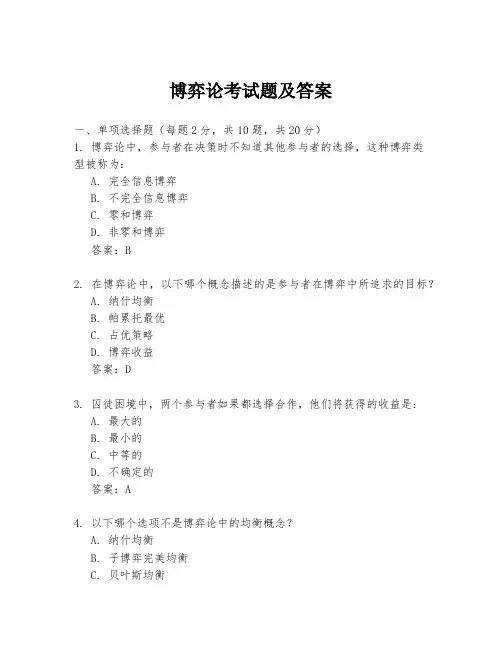
博弈论考试题及答案一、单项选择题(每题2分,共10题,共20分)1. 博弈论中,参与者在决策时不知道其他参与者的选择,这种博弈类型被称为:A. 完全信息博弈B. 不完全信息博弈C. 零和博弈D. 非零和博弈答案:B2. 在博弈论中,以下哪个概念描述的是参与者在博弈中所追求的目标?A. 纳什均衡B. 帕累托最优C. 占优策略D. 博弈收益答案:D3. 囚徒困境中,两个参与者如果都选择合作,他们将获得的收益是:A. 最大的B. 最小的C. 中等的D. 不确定的答案:A4. 以下哪个选项不是博弈论中的均衡概念?A. 纳什均衡B. 子博弈完美均衡C. 贝叶斯均衡答案:D5. 在博弈论中,如果一个策略在任何情况下都是最优的,那么这个策略被称为:A. 占优策略B. 纳什均衡C. 帕累托最优D. 混合策略答案:A6. 博弈论中的“混合策略”是指:A. 参与者随机选择纯策略B. 参与者总是选择相同的策略C. 参与者只选择一种策略D. 参与者不进行策略选择答案:A7. 在博弈论中,如果一个参与者的策略选择不依赖于其他参与者的策略选择,这种策略被称为:A. 占优策略B. 独立策略C. 混合策略D. 纳什均衡答案:A8. 博弈论中,以下哪个概念描述的是所有参与者都不可能通过单方面改变策略来提高自己的收益?A. 帕累托最优B. 纳什均衡C. 占优策略答案:B9. 在博弈论中,如果一个参与者的策略在其他所有参与者的策略给定时是最优的,这种策略被称为:A. 占优策略B. 纳什均衡C. 最优反应D. 混合策略答案:C10. 博弈论中的“动态博弈”是指:A. 参与者同时做出决策的博弈B. 参与者按顺序做出决策的博弈C. 参与者只进行一次决策的博弈D. 参与者不进行决策的博弈答案:B二、多项选择题(每题3分,共5题,共15分)1. 以下哪些是博弈论中的基本类型?A. 合作博弈B. 非合作博弈C. 完全信息博弈D. 不完全信息博弈答案:A, B, C, D2. 在博弈论中,以下哪些是描述均衡的概念?A. 纳什均衡B. 帕累托最优C. 占优策略均衡D. 混合策略均衡答案:A, C, D3. 以下哪些是博弈论中可能的结果?A. 帕累托最优B. 纳什均衡C. 占优策略均衡D. 混合策略均衡答案:A, B, C, D4. 在博弈论中,以下哪些是描述策略的概念?A. 纯策略B. 混合策略C. 占优策略D. 最优反应答案:A, B, C, D5. 以下哪些是博弈论中可能的决策顺序?A. 同时决策B. 顺序决策C. 重复决策D. 单次决策答案:A, B, C, D三、简答题(每题5分,共2题,共10分)1. 请简述博弈论中的“纳什均衡”是什么?答案:纳什均衡是指在一个博弈中,每个参与者都选择了自己的最优策略,并且这些策略在其他参与者的策略给定时是最优的,没有任何一个参与者可以通过单方面改变策略来提高自己的收益。
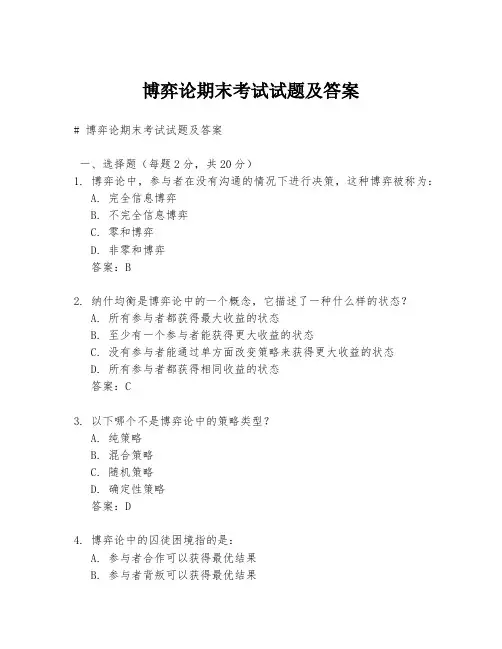
博弈论期末考试试题及答案# 博弈论期末考试试题及答案一、选择题(每题2分,共20分)1. 博弈论中,参与者在没有沟通的情况下进行决策,这种博弈被称为:A. 完全信息博弈B. 不完全信息博弈C. 零和博弈D. 非零和博弈答案:B2. 纳什均衡是博弈论中的一个概念,它描述了一种什么样的状态?A. 所有参与者都获得最大收益的状态B. 至少有一个参与者能获得更大收益的状态C. 没有参与者能通过单方面改变策略来获得更大收益的状态D. 所有参与者都获得相同收益的状态答案:C3. 以下哪个不是博弈论中的策略类型?A. 纯策略B. 混合策略C. 随机策略D. 确定性策略答案:D4. 博弈论中的囚徒困境指的是:A. 参与者合作可以获得最优结果B. 参与者背叛可以获得最优结果C. 参与者合作可以获得次优结果,但背叛可以获得最优结果D. 参与者背叛可以获得次优结果,但合作可以获得最优结果答案:C5. 以下哪个不是博弈论中的基本概念?A. 参与者B. 策略C. 收益D. 概率答案:D...二、简答题(每题10分,共30分)1. 解释什么是博弈论,并给出一个实际生活中的例子。
答案:博弈论是研究具有冲突和合作特征的决策者之间互动的数学理论。
在实际生活中,博弈论的一个例子是拍卖。
在拍卖中,买家(参与者)需要决定出价(策略)以赢得商品(收益),同时考虑其他买家的出价策略。
2. 描述纳什均衡的概念,并解释为什么它在博弈论中如此重要。
答案:纳什均衡是指在非合作博弈中,每个参与者选择自己的最优策略,并且考虑到其他参与者的策略选择时,没有参与者能通过单方面改变策略来获得更大的收益。
纳什均衡在博弈论中非常重要,因为它提供了一种预测参与者行为的方法,即在均衡状态下,参与者没有动机去改变他们的策略。
3. 什么是完全信息博弈和不完全信息博弈?它们之间有什么区别?答案:完全信息博弈是指所有参与者都完全知道博弈的结构和其他参与者的收益函数。
而不完全信息博弈是指至少有一个参与者对博弈的结构或其它参与者的收益函数不完全了解。
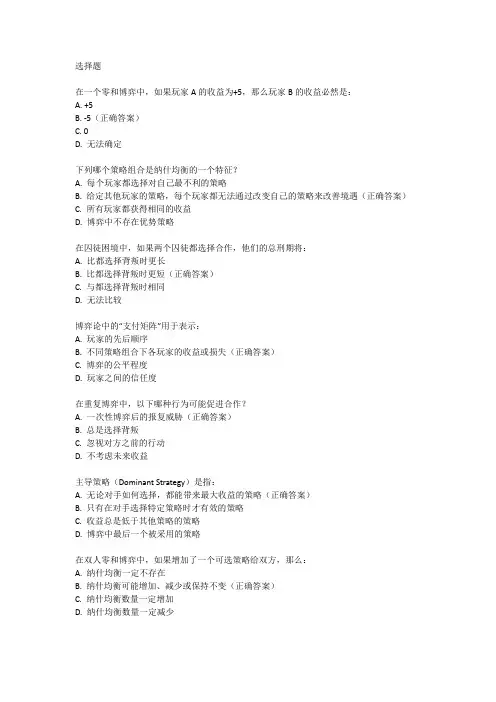
选择题在一个零和博弈中,如果玩家A的收益为+5,那么玩家B的收益必然是:A. +5B. -5(正确答案)C. 0D. 无法确定下列哪个策略组合是纳什均衡的一个特征?A. 每个玩家都选择对自己最不利的策略B. 给定其他玩家的策略,每个玩家都无法通过改变自己的策略来改善境遇(正确答案)C. 所有玩家都获得相同的收益D. 博弈中不存在优势策略在囚徒困境中,如果两个囚徒都选择合作,他们的总刑期将:A. 比都选择背叛时更长B. 比都选择背叛时更短(正确答案)C. 与都选择背叛时相同D. 无法比较博弈论中的“支付矩阵”用于表示:A. 玩家的先后顺序B. 不同策略组合下各玩家的收益或损失(正确答案)C. 博弈的公平程度D. 玩家之间的信任度在重复博弈中,以下哪种行为可能促进合作?A. 一次性博弈后的报复威胁(正确答案)B. 总是选择背叛C. 忽视对方之前的行动D. 不考虑未来收益主导策略(Dominant Strategy)是指:A. 无论对手如何选择,都能带来最大收益的策略(正确答案)B. 只有在对手选择特定策略时才有效的策略C. 收益总是低于其他策略的策略D. 博弈中最后一个被采用的策略在双人零和博弈中,如果增加了一个可选策略给双方,那么:A. 纳什均衡一定不存在B. 纳什均衡可能增加、减少或保持不变(正确答案)C. 纳什均衡数量一定增加D. 纳什均衡数量一定减少在拍卖博弈中,第二价格密封拍卖(Vickrey Auction)的赢家支付的是:A. 自己报出的最高价B. 所有报价中的第二高价(正确答案)C. 拍卖品的真实价值D. 拍卖前设定的底价。
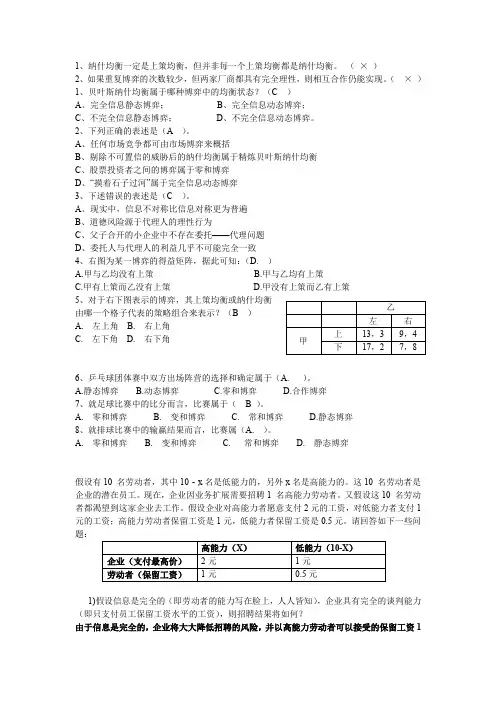
1、纳什均衡一定是上策均衡,但并非每一个上策均衡都是纳什均衡。
(×)2、如果重复博弈的次数较少,但两家厂商都具有完全理性,则相互合作仍能实现。
(×)1、贝叶斯纳什均衡属于哪种博弈中的均衡状态?(C )A、完全信息静态博弈;B、完全信息动态博弈;C、不完全信息静态博弈;D、不完全信息动态博弈。
2、下列正确的表述是(A )。
A、任何市场竞争都可由市场博弈来概括B、剔除不可置信的威胁后的纳什均衡属于精炼贝叶斯纳什均衡C、股票投资者之间的博弈属于零和博弈D、“摸着石子过河”属于完全信息动态博弈3、下述错误的表述是(C )。
A、现实中,信息不对称比信息对称更为普遍B、道德风险源于代理人的理性行为C、父子合开的小企业中不存在委托——代理问题D、委托人与代理人的利益几乎不可能完全一致4、右图为某一博弈的得益矩阵,据此可知:(D. )A.甲与乙均没有上策B.甲与乙均有上策C.甲有上策而乙没有上策D.甲没有上策而乙有上策5、对于右下图表示的博弈,其上策均衡或纳什均衡A.左上角B.右上角C.左下角D.右下角6、乒乓球团体赛中双方出场阵营的选择和确定属于(A. )。
A.静态博弈B.动态博弈C.零和博弈D.合作博弈7、就足球比赛中的比分而言,比赛属于( B )。
A.零和博弈B.变和博弈C.常和博弈D.静态博弈8、就排球比赛中的输赢结果而言,比赛属(A. )。
A.零和博弈B.变和博弈C. 常和博弈D.静态博弈假设有10 名劳动者,其中10 - x名是低能力的,另外x名是高能力的。
这10 名劳动者是企业的潜在员工。
现在,企业因业务扩展需要招聘1 名高能力劳动者。
又假设这10 名劳动者都渴望到这家企业去工作。
假设企业对高能力者愿意支付2元的工资,对低能力者支付1元的工资;高能力劳动者保留工资是1元,低能力者保留工资是0.5元。
请回答如下一些问题:1)假设信息是完全的(即劳动者的能力写在脸上,人人皆知),企业具有完全的谈判能力(即只支付员工保留工资水平的工资),则招聘结果将如何?由于信息是完全的,企业将大大降低招聘的风险,并以高能力劳动者可以接受的保留工资1元,从X名高能力劳动者中招聘到一名员工,市场交易顺利进行。
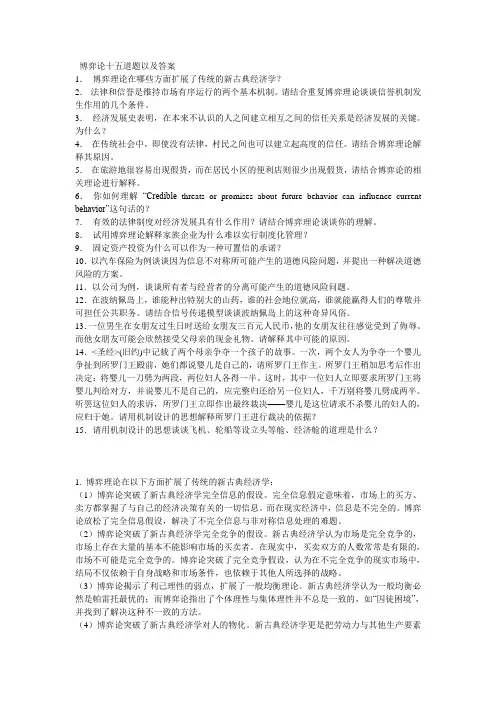
博弈论十五道题以及答案1.博弈理论在哪些方面扩展了传统的新古典经济学?2.法律和信誉是维持市场有序运行的两个基本机制。
请结合重复博弈理论谈谈信誉机制发生作用的几个条件。
3.经济发展史表明,在本来不认识的人之间建立相互之间的信任关系是经济发展的关键。
为什么?4.在传统社会中,即使没有法律,村民之间也可以建立起高度的信任。
请结合博弈理论解释其原因。
5.在旅游地很容易出现假货,而在居民小区的便利店则很少出现假货,请结合博弈论的相关理论进行解释。
6.你如何理解“Credible threats or promises about future behavior can influence current behavior”这句话的?7.有效的法律制度对经济发展具有什么作用?请结合博弈理论谈谈你的理解。
8.试用博弈理论解释家族企业为什么难以实行制度化管理?9.固定资产投资为什么可以作为一种可置信的承诺?10.以汽车保险为例谈谈因为信息不对称所可能产生的道德风险问题,并提出一种解决道德风险的方案。
11.以公司为例,谈谈所有者与经营者的分离可能产生的道德风险问题。
12.在波纳佩岛上,谁能种出特别大的山药,谁的社会地位就高,谁就能赢得人们的尊敬并可担任公共职务。
请结合信号传递模型谈谈波纳佩岛上的这种奇异风俗。
13.一位男生在女朋友过生日时送给女朋友三百元人民币,他的女朋友往往感觉受到了侮辱。
而他女朋友可能会欣然接受父母亲的现金礼物。
请解释其中可能的原因。
14.<圣经>(旧约)中记载了两个母亲争夺一个孩子的故事。
一次,两个女人为争夺一个婴儿争扯到所罗门王殿前,她们都说婴儿是自己的,请所罗门王作主。
所罗门王稍加思考后作出决定:将婴儿一刀劈为两段,两位妇人各得一半。
这时,其中一位妇人立即要求所罗门王将婴儿判给对方,并说婴儿不是自己的,应完整归还给另一位妇人,千万别将婴儿劈成两半。
听罢这位妇人的求诉,所罗门王立即作出最终裁决——婴儿是这位请求不杀婴儿的妇人的,应归于她。
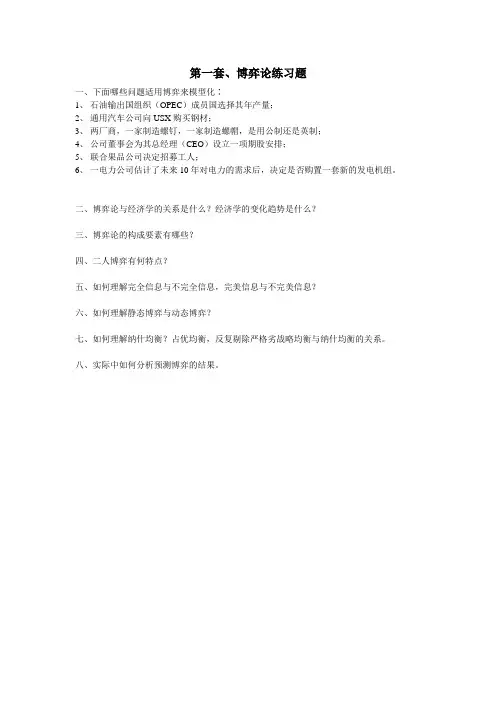
第一套、博弈论练习题一、下面哪些问题适用博弈来模型化∶1、石油输出国组织(OPEC)成员国选择其年产量;2、通用汽车公司向USX购买钢材;3、两厂商,一家制造螺钉,一家制造螺帽,是用公制还是英制;4、公司董事会为其总经理(CEO)设立一项期股安排;5、联合果品公司决定招募工人;6、一电力公司估计了未来10年对电力的需求后,决定是否购置一套新的发电机组。
二、博弈论与经济学的关系是什么?经济学的变化趋势是什么?三、博弈论的构成要素有哪些?四、二人博弈有何特点?五、如何理解完全信息与不完全信息,完美信息与不完美信息?六、如何理解静态博弈与动态博弈?七、如何理解纳什均衡?占优均衡,反复剔除严格劣战略均衡与纳什均衡的关系。
八、实际中如何分析预测博弈的结果。
第二套、博弈论练习题一、构造具有下述性质的2*2博弈的例子1、不存在纯战略纳什均衡;2、不存在弱帕累托优势战略组合;3、至少有两个纳什均衡,其中一个帕累托优于其它所有的战略组合;4、至少有三个纳什均衡。
二、不协调博弈有一男一女,各自选择是看足球还是看时装表演。
男的愿意看足球,女的喜欢看时装。
男的想和女方在一起,女的却想躲开男方。
1、构造一个博弈矩阵来表示这个博弈,选择相应的数值以符合男、女的偏好;2、若女方先采取行动,将发生什么?3、该博弈中存在先动优势吗?4、在完全信息的静态博弈中,存在纯战略纳什均衡吗?三、变化的囚徒困境在X与Y两囚徒博弈中,X有前科,故无论谁坦白或抵赖,X都至少要比Y多判5年。
构造一个博弈矩阵,并找出该博弈的纳什均衡。
四、有两个厂商的古诺模型,q i是厂商i的产量,Q=q1+q2为市场总产量。
价格为产量的减函数,且p(Q)=a - Q,没有固定成本,但边际成本不同,分别为c1和c2。
如果0<c i<a/2,问纳什均衡的产量各为多少?如果c1<c2<a,但2c2>a+c1,则纳什均衡的产量又为多少?五、有如下博弈矩阵求解混合纳什均衡。

《博弈论》习题一、单项选择题1.博弈论中,局中人从一个博弈中得到的结果常被称为()。
A. 效用B. 支付C. 决策D. 利润2.博弈中通常包括下面的内容,除了()。
A.局中人B.占优战略均衡C.策略D.支付3.在具有占优战略均衡的囚徒困境博弈中()。
A.只有一个囚徒会坦白B.两个囚徒都没有坦白C.两个囚徒都会坦白D.任何坦白都被法庭否决了4.在多次重复的双头博弈中,每一个博弈者努力()。
A.使行业的总利润达到最大B.使另一个博弈者的利润最小C.使其市场份额最大D.使其利润最大5.一个博弈中,直接决定局中人支付的因素是()。
A. 策略组合B. 策略C. 信息D. 行动6.对博弈中的每一个博弈者而言,无论对手作何选择,其总是拥有惟一最佳行为,此时的博弈具有()。
A.囚徒困境式的均衡B.一报还一报的均衡C.占优策略均衡D.激发战略均衡7.如果另一个博弈者在前一期合作,博弈者就在现期合作;但如果另一个博弈者在前一期违约,博弈者在现期也违约的策略称为()。
A.一报还一报的策略B.激发策略C.双头策略D.主导企业策略8.在囚徒困境的博弈中,合作策略会导致()。
A.博弈双方都获胜B.博弈双方都失败C.使得先采取行动者获胜D.使得后采取行动者获胜9.在什么时候,囚徒困境式博弈均衡最可能实现()。
A. 当一个垄断竞争行业是由一个主导企业控制时B.当一个寡头行业面对的是重复博弈时C.当一个垄断行业被迫重复地与一个寡头行业博弈时D. 当一个寡头行业进行一次博弈时10.一个企业采取的行为与另一个企业在前一阶段采取的行为一致,这种策略是一种()。
A.主导策略B.激发策略C.一报还一报策略D.主导策略11.关于策略式博弈,正确的说法是()。
A. 策略式博弈无法刻划动态博弈B. 策略式博弈无法表明行动顺序C. 策略式博弈更容易求解D. 策略式博弈就是一个支付矩阵12.下列关于策略的叙述哪个是错误的():A. 策略是局中人选择的一套行动计划;B. 参与博弈的每一个局中人都有若干个策略;C. 一个局中人在原博弈中的策略和在子博弈中的策略是相同的;D. 策略与行动是两个不同的概念,策略是行动的规则,而不是行动本身。
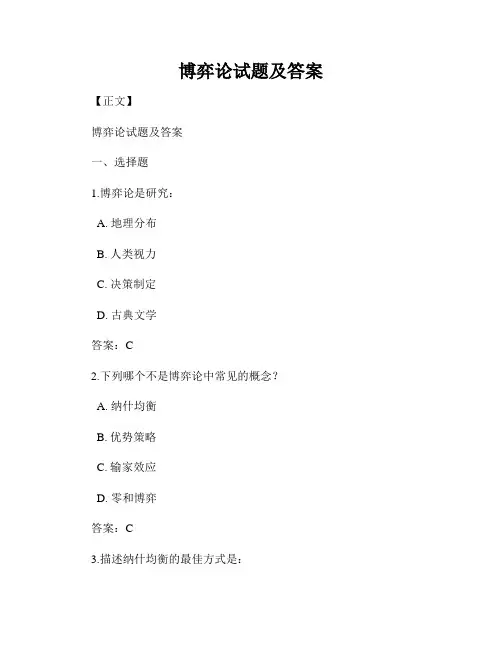
博弈论试题及答案【正文】博弈论试题及答案一、选择题1.博弈论是研究:A. 地理分布B. 人类视力C. 决策制定D. 古典文学答案:C2.下列哪个不是博弈论中常见的概念?A. 纳什均衡B. 优势策略C. 输家效应D. 零和博弈答案:C3.描述纳什均衡的最佳方式是:A. 所有参与者都达到最佳策略B. 至少有一个参与者达到最佳策略C. 所有参与者都达到次优策略D. 至少有一个参与者达到次优策略答案:A4.下列哪个案例体现了零和博弈的情况?A. 两国签订贸易协定B. 赌徒在赌博中争夺赌注C. 两家公司合作推出新产品D. 好友一起玩棋盘游戏答案:B5.下列哪个不是博弈论的应用之一?A. 经济决策B. 政治博弈C. 生物进化D. 音乐创作答案:D二、填空题1.博弈论最早由_____________等人于20世纪40年代提出。
答案:冯·诺依曼(John von Neumann)2.博弈论是研究参与者间的_____________和_____________的学科。
答案:互动行为;决策制定3.零和博弈是指参与者的利益总和恒为_____________。
答案:零4.博弈论中的最佳策略指的是在其他参与者采取某个策略时,使某一参与者的_____________最大化的策略。
答案:利益5.斯坦福大学的_____________教授以其对博弈论的突出贡献而获得2005年诺贝尔经济学奖。
答案:约翰·纳什(John Nash)三、简答题1.简要解释博弈论中的纳什均衡。
答:纳什均衡是博弈论中的一个重要概念,指的是在参与者选择自己最佳策略的情况下,不存在任何一个参与者可以通过单独改变自己的策略来获得更好收益的状态。
简言之,纳什均衡是一种理性选择下的稳定状态。
2.举例说明博弈论在实际生活中的应用。
答:博弈论在经济学、政治学、生物学等领域中都有广泛应用。
例如,在贸易谈判中,两个国家之间的博弈就是典型的博弈论应用。
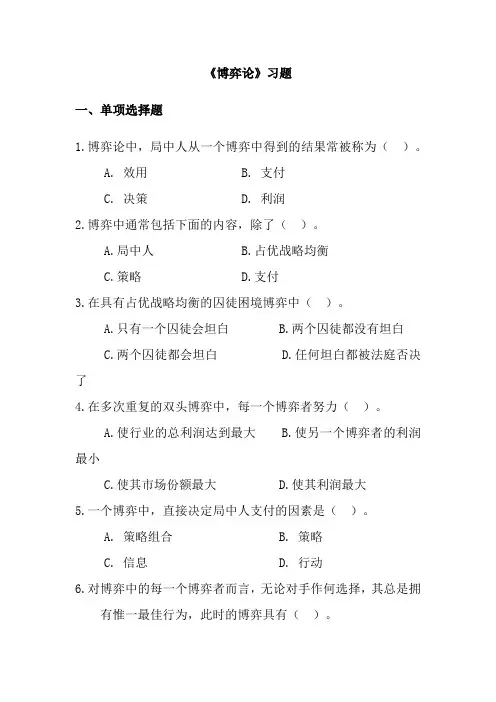
《博弈论》习题一、单项选择题1.博弈论中,局中人从一个博弈中得到的结果常被称为()。
A. 效用B. 支付C. 决策D. 利润2.博弈中通常包括下面的内容,除了()。
A.局中人B.占优战略均衡C.策略D.支付3.在具有占优战略均衡的囚徒困境博弈中()。
A.只有一个囚徒会坦白B.两个囚徒都没有坦白C.两个囚徒都会坦白D.任何坦白都被法庭否决了4.在多次重复的双头博弈中,每一个博弈者努力()。
A.使行业的总利润达到最大B.使另一个博弈者的利润最小C.使其市场份额最大D.使其利润最大5.一个博弈中,直接决定局中人支付的因素是()。
A. 策略组合B. 策略C. 信息D. 行动6.对博弈中的每一个博弈者而言,无论对手作何选择,其总是拥有惟一最佳行为,此时的博弈具有()。
A.囚徒困境式的均衡B.一报还一报的均衡C.占优策略均衡D.激发战略均衡7.如果另一个博弈者在前一期合作,博弈者就在现期合作;但如果另一个博弈者在前一期违约,博弈者在现期也违约的策略称为()。
A.一报还一报的策略B.激发策略C.双头策略D.主导企业策略8.在囚徒困境的博弈中,合作策略会导致()。
A.博弈双方都获胜B.博弈双方都失败C.使得先采取行动者获胜D.使得后采取行动者获胜9.在什么时候,囚徒困境式博弈均衡最可能实现()。
A. 当一个垄断竞争行业是由一个主导企业控制时B.当一个寡头行业面对的是重复博弈时C.当一个垄断行业被迫重复地与一个寡头行业博弈时D. 当一个寡头行业进行一次博弈时10.一个企业采取的行为与另一个企业在前一阶段采取的行为一致,这种策略是一种()。
A.主导策略B.激发策略C.一报还一报策略D.主导策略11.关于策略式博弈,正确的说法是()。
A. 策略式博弈无法刻划动态博弈B. 策略式博弈无法表明行动顺序C. 策略式博弈更容易求解D. 策略式博弈就是一个支付矩阵12.下列关于策略的叙述哪个是错误的():A. 策略是局中人选择的一套行动计划;B. 参与博弈的每一个局中人都有若干个策略;C. 一个局中人在原博弈中的策略和在子博弈中的策略是相同的;D. 策略与行动是两个不同的概念,策略是行动的规则,而不是行动本身。
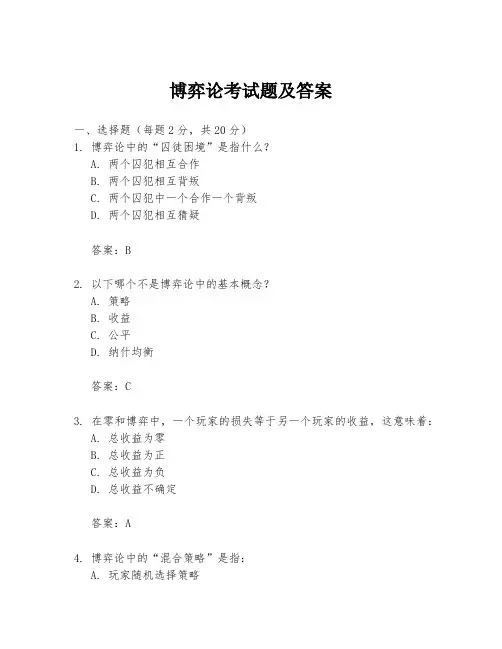
博弈论考试题及答案一、选择题(每题2分,共20分)1. 博弈论中的“囚徒困境”是指什么?A. 两个囚犯相互合作B. 两个囚犯相互背叛C. 两个囚犯中一个合作一个背叛D. 两个囚犯相互猜疑答案:B2. 以下哪个不是博弈论中的基本概念?A. 策略B. 收益C. 公平D. 纳什均衡答案:C3. 在零和博弈中,一个玩家的损失等于另一个玩家的收益,这意味着:A. 总收益为零B. 总收益为正C. 总收益为负D. 总收益不确定答案:A4. 博弈论中的“混合策略”是指:A. 玩家随机选择策略B. 玩家固定选择一种策略C. 玩家根据对手的策略选择策略D. 玩家不使用策略答案:A5. 以下哪个是博弈论中的“完全信息”博弈?A. 拍卖博弈B. 石头剪刀布C. 桥牌D. 信息不对称博弈答案:C6. 博弈论中的“重复博弈”指的是:A. 博弈只进行一次B. 博弈进行多次C. 博弈进行无限次D. 博弈进行有限次但次数未知答案:B7. 以下哪个是博弈论中的“动态博弈”?A. 零和博弈B. 非零和博弈C. 同时博弈D. 顺序博弈答案:D8. 在博弈论中,如果一个策略组合是纳什均衡,那么:A. 每个玩家都有动机单方面改变策略B. 每个玩家都满足于当前策略C. 至少有一个玩家不满意当前策略D. 所有玩家都不满意当前策略答案:B9. 博弈论中的“合作博弈”是指:A. 玩家之间可以形成联盟B. 玩家之间不能形成联盟C. 玩家之间只能通过竞争来获得收益D. 玩家之间只能通过合作来获得收益答案:A10. 以下哪个是博弈论中的“公共知识”?A. 每个玩家的收益函数B. 每个玩家的策略选择C. 每个玩家的偏好D. 每个玩家的个人信息答案:A二、简答题(每题10分,共30分)1. 简述博弈论中的“纳什均衡”概念。
答案:纳什均衡是指在一个博弈中,每个玩家都选择了自己的最优策略,并且没有玩家能够通过单方面改变策略来提高自己的收益。
在纳什均衡状态下,每个玩家的策略是对其他玩家策略的最优反应。
经济博弈论试题及答案一、选择题(每题2分,共20分)1. 博弈论中的“纳什均衡”是由哪位经济学家提出的?A. 亚当·斯密B. 约翰·纳什C. 保罗·萨缪尔森D. 米尔顿·弗里德曼答案:B2. 在完全信息博弈中,参与者对其他参与者的策略和收益函数了解多少?A. 完全不了解B. 部分了解C. 完全了解D. 只了解自己的收益函数答案:C3. 以下哪个是博弈论中的基本概念?A. 边际成本B. 边际效用C. 策略组合D. 机会成本答案:C4. 囚徒困境中,如果两个囚徒都选择不合作,他们将面临什么结果?A. 获得最大利益B. 获得最小利益C. 获得中等利益D. 无法预测答案:B5. 以下哪个不是博弈论中的策略类型?A. 纯策略B. 混合策略C. 随机策略D. 固定策略答案:D二、简答题(每题10分,共30分)6. 简述博弈论在经济学中的应用。
答案:博弈论在经济学中的应用广泛,包括但不限于市场结构分析、拍卖理论、竞争策略、合作与联盟形成、公共品提供、以及政策制定等。
博弈论帮助经济学家理解个体在不同情境下的决策行为,预测市场动态,为政策制定提供理论依据。
7. 解释什么是“零和博弈”。
答案:零和博弈是一种特殊类型的博弈,其中参与者的总收益为零。
这意味着一个参与者的收益增加必然伴随着另一个参与者的损失,整个博弈的总收益是不变的。
这种博弈通常涉及到竞争关系,而非合作。
8. 描述“重复博弈”的特点。
答案:重复博弈是指同样的博弈结构在一定时间间隔内重复进行多次。
其特点包括参与者可以学习对手的行为模式,策略可能随时间调整,以及长期合作的可能性增加。
重复博弈中的策略选择往往更加复杂,因为参与者需要考虑未来博弈的影响。
三、计算题(每题25分,共50分)9. 假设有两个公司A和B,它们可以选择高成本生产(H)或低成本生产(L)。
如果两个公司都选择H,它们各自获得利润为100万元;如果都选择L,各自获得利润为50万元;如果一个选择H而另一个选择L,选择L的公司获得150万元利润,而选择H的公司则亏损50万元。
博弈论考试题及答案### 博弈论考试题及答案#### 一、选择题(每题5分,共20分)1. 在博弈论中,以下哪个概念描述了参与者在没有沟通的情况下,各自选择最优策略的情况?A. 纳什均衡B. 帕累托最优C. 合作博弈D. 零和博弈答案:A2. 囚徒困境中,如果两个参与者都选择合作,他们将获得较低的收益,但如果都选择背叛,则会获得更低的收益。
这种情况被称为:A. 纳什均衡B. 帕累托最优C. 帕累托改进D. 帕累托最差答案:A3. 在博弈论中,哪种类型的博弈涉及到参与者之间的合作?A. 零和博弈B. 非零和博弈C. 完全信息博弈D. 不完全信息博弈答案:B4. 博弈论中,哪个概念描述了参与者在知道所有可能的策略和收益后,做出的最优选择?A. 完全信息B. 不完全信息C. 共同知识D. 混合策略答案:A#### 二、简答题(每题10分,共40分)1. 描述博弈论中的“纳什均衡”概念,并给出一个实际生活中的例子。
纳什均衡是指在一个博弈中,每个参与者选择了最优策略,并且考虑到其他参与者的策略后,没有动机单方面改变策略。
例如,在价格战中,两家公司都选择降低价格以吸引更多顾客,如果任何一家公司单独提高价格,它将失去市场份额,因此两家公司都维持较低的价格,形成了纳什均衡。
2. 解释什么是“帕累托最优”,并说明它与纳什均衡的关系。
帕累托最优是指在一个经济状态下,没有任何个体可以在不损害其他个体的情况下改善自己的状况。
它与纳什均衡的关系在于,纳什均衡不一定达到帕累托最优,但帕累托最优的状态一定是纳什均衡。
3. 什么是“混合策略”?请举例说明。
混合策略是指参与者在博弈中以一定的概率选择不同的策略。
例如,在石头、剪刀、布的游戏中,每个玩家可能会以不同的概率选择石头、剪刀或布,以增加对手预测的难度。
4. 描述“动态博弈”与“静态博弈”的区别。
动态博弈是指参与者的决策是顺序进行的,每个参与者的决策依赖于之前参与者的行动。
博弈论复习题及答案1. 博弈论中,非合作博弈与合作博弈的主要区别是什么?答案:非合作博弈是指参与者之间没有约束性协议的博弈,每个参与者都独立地选择自己的策略以最大化自己的利益。
而合作博弈则允许参与者之间形成具有约束力的协议,共同合作以达到共同的目标。
2. 什么是纳什均衡?答案:纳什均衡是指在一个博弈中,每个参与者都选择了最优策略,并且考虑到其他参与者的策略后,没有参与者有动机单方面改变自己的策略。
3. 零和博弈与非零和博弈有何不同?答案:零和博弈是指博弈中所有参与者的收益总和为零,即一个参与者的收益必然导致另一个参与者的损失。
非零和博弈则是指参与者的收益总和不为零,参与者之间可能存在合作共赢的情况。
4. 如何判断一个博弈是否存在纯策略纳什均衡?答案:可以通过构建博弈的收益矩阵,然后寻找每个参与者在其他参与者策略给定的情况下的最佳响应策略。
如果存在一组策略,使得每个参与者在其他参与者策略不变的情况下,都没有动机改变自己的策略,那么这个策略组合就是一个纯策略纳什均衡。
5. 混合策略纳什均衡与纯策略纳什均衡有何不同?答案:纯策略纳什均衡是指参与者在均衡状态下选择的策略是确定的,而混合策略纳什均衡则是指参与者在均衡状态下选择的策略是随机的,每个策略都有一定的概率被选择。
6. 什么是支配策略?答案:支配策略是指在博弈中,无论其他参与者选择什么策略,某个参与者选择该策略都能获得比其他策略更好的结果。
7. 博弈论中的“囚徒困境”说明了什么?答案:“囚徒困境”说明了即使合作对所有参与者都有利,但由于缺乏信任和沟通,参与者可能会选择对自身最有利的策略,导致集体结果不是最优的。
8. 什么是博弈论中的“倒后归纳法”?答案:“倒后归纳法”是一种解决动态博弈的方法,通过从博弈的最后阶段开始,逆向分析每个阶段的最优策略,直到博弈的初始阶段。
9. 博弈论在经济学中的应用有哪些?答案:博弈论在经济学中的应用非常广泛,包括但不限于市场结构分析、拍卖理论、合同理论、产业组织、宏观经济政策分析等。
博弈论练习题(一)一、下面哪些问题适用博弈来模型化∶1、石油输出国组织(OPEC)成员国选择其年产量;2、通用汽车公司向USX购买钢材;3、两厂商,一家制造螺钉,一家制造螺帽,是用公制还是英制;4、公司董事会为其总经理(CEO)设立一项期股安排;5、联合果品公司决定招募工人;6、一电力公司估计了未来10年对电力的需求后,决定是否购置一套新的发电机组。
问题1和3可以用博弈来模型化二、博弈论与经济学的关系是什么?经济学的变化趋势是什么?答:(1)博弈论与经济学的关系:1、博弈论在经济学中的应用最广泛、最成功。
2、经济学家对博弈论的贡献越来越大。
3、经济学和博弈论研究的模式是一样的。
经济学和博弈论都强调个人理性,即在给定的约束条件下追求效用最大化。
(2)经济学发展的几个趋势博弈论成为主流经济学的基石,反映了经济学发展的几个趋势∶1、经济学研究的对象越来越转向个体。
2、经济学越来越转向人与人关系的研究,特别是人与人之间行为的相互影响及作用,人们之间利益的一致与冲突,竞争与合作的研究。
3、经济学越来越重视对信息的研究,特别是信息不对称对个人选择及制度安排的影响。
三、博弈论的构成要素有哪些?答:广义上讲博弈论则主要由以下五大要素构成:一,决策主体(Player):又称局中人或博弈方,指的是博弈中能独立决策、独立行动并承担决策结果的个人或组织。
二,策略空间(Strategy space):又称策略集,是指供参与者选择的策略和行动空间。
三,效用(Utility):也就是博弈者之间相互争夺的利益。
博弈双方或多方都是围绕一定利益展开的,因此博弈胜负的评判结果主要是靠策略选择后的得失来衡量。
四,次序(Orders):即各博弈方在决策时有先后之分,因为博弈方在决策选择上要不时地调整改善,一定要十分注重次序轻重的问题。
如果决策的次序和实施时间不同,则博弈的结果必会有所差别。
五,博弈均衡:博弈虽然是为了利益和胜利,但并非是利益尽占,而是要遵循均衡理论。
《博弈论》习题一、单项选择题1.博弈论中,局中人从一个博弈中得到的结果常被称为()。
A. 效用B. 支付C. 决策D. 利润2.博弈中通常包括下面的内容,除了()。
A.局中人B.占优战略均衡C.策略D.支付3.在具有占优战略均衡的囚徒困境博弈中()。
A.只有一个囚徒会坦白B.两个囚徒都没有坦白C.两个囚徒都会坦白D.任何坦白都被法庭否决了4.在多次重复的双头博弈中,每一个博弈者努力()。
A.使行业的总利润达到最大B.使另一个博弈者的利润最小C.使其市场份额最大D.使其利润最大5.一个博弈中,直接决定局中人支付的因素是()。
A. 策略组合B. 策略C. 信息D. 行动6.对博弈中的每一个博弈者而言,无论对手作何选择,其总是拥有惟一最佳行为,此时的博弈具有()。
A.囚徒困境式的均衡B.一报还一报的均衡C.占优策略均衡D.激发战略均衡7.如果另一个博弈者在前一期合作,博弈者就在现期合作;但如果另一个博弈者在前一期违约,博弈者在现期也违约的策略称为()。
A.一报还一报的策略B.激发策略C.双头策略D.主导企业策略8.在囚徒困境的博弈中,合作策略会导致()。
A.博弈双方都获胜B.博弈双方都失败C.使得先采取行动者获胜D.使得后采取行动者获胜9.在什么时候,囚徒困境式博弈均衡最可能实现()。
A. 当一个垄断竞争行业是由一个主导企业控制时B.当一个寡头行业面对的是重复博弈时C.当一个垄断行业被迫重复地与一个寡头行业博弈时D. 当一个寡头行业进行一次博弈时10.一个企业采取的行为与另一个企业在前一阶段采取的行为一致,这种策略是一种()。
A.主导策略B.激发策略C.一报还一报策略D.主导策略11.关于策略式博弈,正确的说法是()。
A. 策略式博弈无法刻划动态博弈B. 策略式博弈无法表明行动顺序C. 策略式博弈更容易求解D. 策略式博弈就是一个支付矩阵12.下列关于策略的叙述哪个是错误的():A. 策略是局中人选择的一套行动计划;B. 参与博弈的每一个局中人都有若干个策略;C. 一个局中人在原博弈中的策略和在子博弈中的策略是相同的;D. 策略与行动是两个不同的概念,策略是行动的规则,而不是行动本身。
博弈论复习题及答案博弈论是研究决策者在相互影响的情况下如何做出决策的理论。
以下是一些博弈论的复习题及答案,供学习者参考:一、选择题1. 博弈论中最基本的博弈类型是什么?A. 零和博弈B. 非零和博弈C. 完全信息博弈D. 不完全信息博弈答案: A. 零和博弈2. 在博弈论中,纳什均衡指的是什么?A. 一种博弈的最终结果B. 一种博弈的初始状态C. 一种策略组合,其中没有任何一个参与者能够通过单方面改变策略而获得更好的结果D. 一种策略组合,其中所有参与者都希望改变策略以获得更好的结果答案: C. 一种策略组合,其中没有任何一个参与者能够通过单方面改变策略而获得更好的结果3. 囚徒困境中,两个囚犯的最优策略是什么?A. 相互合作B. 相互背叛C. 一个合作,一个背叛D. 一个背叛,一个合作答案: B. 相互背叛二、简答题1. 解释什么是“混合策略”并给出一个例子。
答案:混合策略是指参与者在博弈中选择不同策略的概率分布。
例如,在石头、剪刀、布的游戏中,一个玩家可能会以1/3的概率选择石头,1/3的概率选择剪刀,和1/3的概率选择布,这就是一个混合策略的例子。
2. 描述什么是“重复博弈”以及它与单次博弈的区别。
答案:重复博弈是指同样的博弈结构在一定时间内多次进行。
与单次博弈相比,重复博弈允许参与者根据对手过去的行动来调整自己的策略,这可能会导致合作行为的出现,因为参与者会考虑到未来博弈的潜在收益。
三、论述题1. 论述博弈论在经济学中的应用,并给出至少两个具体的例子。
答案:博弈论在经济学中有广泛的应用。
例如:- 拍卖理论:博弈论可以用来分析拍卖中的竞价行为,确定最优的拍卖机制。
- 竞争策略:企业在制定市场进入、定价和广告策略时,会使用博弈论来预测竞争对手的行为并做出相应的决策。
2. 讨论囚徒困境在现实世界中可能的应用场景,并解释为什么合作有时是困难的。
答案:囚徒困境在现实世界中的应用场景包括但不限于:- 国际关系:国家之间的军备竞赛可以看作是囚徒困境的一种形式,合作减少军备可以带来共同的利益,但由于缺乏信任,每个国家都倾向于增加自己的军备。
Brigham Young University Department of EconomicsEconomics 381 – Intermediate MacroeconomicsDr. Phillips (sections 2 & 4) Winter Semester 2005Midterm Exam 2 keyMar. 11 - 12, 2005This exam is closed book and closed notes, though you may use a calculator. Read all questions carefully before answering. Write your answers legibly in the space provided. Keep your answers concise and correct. Points will be deducted for answers which are irrelevant to the question. You may use a testing center calculator to help with the math, if you wish.Section I (multiple choice, 2 points each) Circle the letter of the correct answer.1. Consumption smoothing refers to(a) the tendency of all consumers to choose the same amount of current consumption.(b) the tendency of consumers to seek a consumption path over time that is smoother than income.(c) the tendency of consumers to seek an income path over time that is smoother than consumption.(d) consumer’s concerns about going heavily into debt.2. An increase in first-period income results in(a) an increase in first-period consumption, an increase in second-period consumption, and an increase insaving.(b) an increase in first-period consumption, a decrease in second-period consumption, and an increase in saving.(c) a decrease in first-period consumption, an increase in second-period consumption, and an increase in saving.(d) an increase in first-period consumption, an increase in second-period consumption, and a decrease in saving.3. An increase in the real interest rate is an example of a(a) pure substitution effect.(b) substitution effect and a positive income effect.(c) substitution effect and a negative income effect.(d) substitution effect and an income effect whose sign depends on whether the consumer is initially aborrower or a lender.4. An increase in lifetime wealth is likely to(a) increase current labor supply and increase current consumption demand.(b) increase current labor supply and decrease current consumption demand.(c) decrease current labor supply and increase current consumption demand.(d) decrease current labor supply and decrease current consumption demand.5. When drawn against the current real wage, the labor demand curve is(a) upward sloping because the marginal product of labor rises with the quantity of labor employed.(b) upward sloping because the marginal product of labor declines with the quantity of labor employed.(c) downward sloping because the marginal product of labor rises with the quantity of labor employed.(d) downward sloping because the marginal product of labor declines with the quantity of labor employed.6. When drawn against the real interest rate, the output demand curve shifts to the right when(a) current total factor productivity z increases.(b) current total factor productivity z decreases.(c) future total factor productivity z′ increases.(d) future total factor productivity z′ decreases.7. The two most common types of money in circulation in the United States today consist of(a) private bank notes and commodity-backed paper currency.(b) commodity-backed paper currency and fiat money.(c) fiat money and transaction deposits at banks.(d) transaction deposits at banks and commodity money.8. The current demand for money increases whenincome decreases.(a) currentreal(b) future real income decreases.(c) the nominal rate of interest decreases.(d) none of the above.9. If an increase in the level of the money supply results in a proportionate increase in prices with no effect on any real variables, we say that(a) the Fisher relationship holds.neutral.is(b) money(c) money is superneutral.(d) money is the most preferred store of value.10. In the Friedman-Lucas money surprise model, a surprise increase in the money supply(a) has no effect on the price level.(b) increases the price level less than in proportion to the increase in the money supply.(c) increases the price level in an equal proportion to the increase in the money supply.(d) increases the price level more than in proportion to the increase in the money supply.11. The basic real business cycle model has some difficulty explaining why(a) consumption is procyclical.(b) investment is procyclical.(c) the price level is countercyclical.(d) the money supply is procyclical.12. The coordination failure model is based on the possibility of increasing returns to scale(a) both at the aggregate level and at the level of the individual firm.(b) at the aggregate level, but not at the level of the individual firm.(c) at the level of the individual firm, but not at the aggregate level.(d) in future periods, but not in the current period.13. In the Keynesian sticky wage model, the aggregate supply curve is upward sloping because, at the fixed nominal wage, an increase in the price level(a) increases the real wage and increases labor supply.(b) increases the real wage and increases labor demand.(c) decreases the real wage and increases labor supply.(d) decreases the real wage and increases labor demand.14. The LM curve represents(a) output–price level combinations at which money supply and money demand are equal.(b) output–real interest rate combinations at which money supply and money demand are equal.(c) real interest rate–price level combinations at which money supply and money demand are equal.(d) none of the above.15. In the Keynesian sticky wage model, the aggregate demand curve represents combinations of(a) the price level and the level of output at which the goods market and the labor market are in equilibrium.(b) the price level and the level of output at which the goods market and the money market are inequilibrium.(c) the real interest rate and the level of output at which the goods market and the labor market are inequilibrium.(d) the real interest rate and the level of output at which the goods market and the money market are inequilibrium.Section II (short answer, 5 points each) Where appropriate show your work as this may help in assigning partial credit if you get the answer wrong.16. Briefly explain the notion of Ricardian equivalence. What does it imply about government deficits?Ricardian equivalence says that the method of government finance has no real effects. While the level of government spending may have real effects, the way the government obtains the funds necessary to purchase goods and services; be it taxes, money creation, or borrowing, is irrelevant for real variables.This means that government deficits will have no effects on the level of economic activity.17. Explain how one goes about deriving an output supply curve (Y s) plotting interest rates against levels of output.The output supply curve is derived from equilibrium in the labor market. Starting with an arbitrarily chosen real interest rate, one finds equilibrium in the labor market which generates a level of real output (via the aggregate production function). If a higher interest rate is chosen, household will choose to consume more in later periods and less today, which includes less leisure time. As a consequence the labor supply curve shifts to the right and more labor is hired. This gives higher output. Hence, the Y s curve slopes upward (has a positive slope).18. Explain how one goes about deriving an output demand curve (Y d) plotting interest rates against levels of output.The output demand curve is derived from the expenditure approach to GDP, which can be written asY=C+I+G in the closed economy case. C is a function of Y, while I and G are not. Starting with an arbitrarily chosen real interest rate, one finds equilibrium demand for output as the value of Y that solvesY=C(Y)+I+G. I and C are both functions of the interest rate. If a higher interest rate is chosen, household will choose to consume more in later periods and less today. In addition, firms will chose a smaller capital stock and investment will be smaller. Both of these effects lead to lower demand for output goods. Hence the Y d curve slopes downward (has a negative slope).19. Using the monetary equilibrium from chapter 10, explain what things can cause an increase in the price level.An increase in money supply shifts the M s curve to theright and the price level rises.A decrease in real money demand (L), rotates the Mdcurve counterclockwise and the price level also rises. Thiscould be caused by a drop in GDP or by an increase in thereal interest rate.20. (10 points) For each of the following models of business cycles, list the assumed primary source of shocks. Is the model an equilibrium or disequilibrium one? What school of thought is it associated with? Also comment on how well the models fit the U.S. data on business cycles.Model shocks typeschool fit MonetarySurprises –Unexpectedchanges in moneysupplyequilibrium Monetarist Poor fit for: prices, avg. laborprod.Real BusinessCycles –Productivity equilibriumNeoclassicalorReal Business CycleExcellent fit, cannot explainmoney movements CoordinationFailure –Consumerconfidenceequilibrium Keynesian Excellent fit, cannot explainmoney movementsSticky Prices – Consumerconfidencedisequilibrium Keynesian Poor fit for: prices, avg. laborprod.Sticky Wages – Consumerconfidencedisequilibrium Keynesian Poor fit for: prices, avg. laborprod.Section III (longer analysis, 20 points each)21. Using the real business cycle set-up and appropriate graphs, show the response of real wages, employment, real interest rates, output & prices to a permanent increase in the price of oil.Nd shifts downward as the marginal product of labor falls.Both Ns and Yd shift due to changes in lifetime wealth which lead to decreases in current consumption of goods and leisure. In addition, the drop in tomorrow’s marginal product of capital causes investment to fall, which reinforces the shift in Yd.The change in labor market equilibrium causes a shift in the Ys curve.Equilbrium is characterized by an ambiguous change in interest rates (r), and a lower level of output (Y)This leads to lower demand for real money which causes a rotation of the Md curve in a counter clockwise direction and gives higher prices (P).To find the change in wages & employment we note that interest rates have not changed substantially. Hence, there is little or no secondary effect that shifts Ns as a movement along the Ys curve, and the diagram is approximately correct as it is drawn. Hence, wages (w) have an ambiguous movement, and employment (N) falls.22. Using the sticky wage setup and appropriate graphs, show the response of real wages, employment, real interest rates, output & prices to a drop in consumer confidence.A drop in consumer confidence will shift the IS curve to the left, since it lowers demand for consumption goods today even if the interest rate does not change. There is also an increase in long-run labor supply, but this is irrelevant, since sticky wage contracts have fixed labor supply in the short-run.The shift in the IS curve causes the AD curve to shift to the left. This gives a decrease in prices (P) and output (Y).The drop in prices causes the LM curve to shift outward and the labor supply curve to shift upward. Hence, interest rates (r) unambiguously fall, real wages (w) rise, and employment (N) falls.。